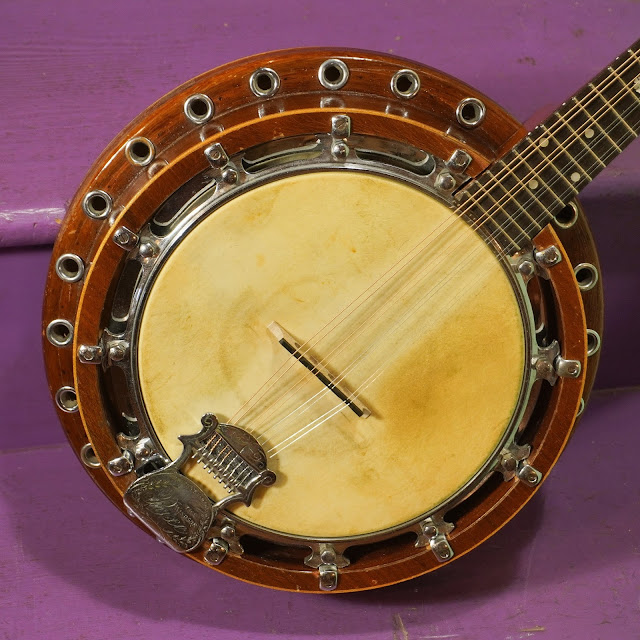1930s Windsor (British-made) Resonator Banjo-Mandolin
Yessir, it's got that "clop-clop" horse-hoof sound in spades. That's what I call the "good" banjo-mandolin sound. It makes you want to play lead off of crosspicked drones. Fun! The "bad" banjo-mandolin sound is when the things are so overbearing with overtones and odd, out-of-tune sustain that you want to pitch the instrument in the river.
A local customer dropped this off ages ago and I stowed it as a "this needs some serious work" project in the back of my mind for some reason, so I forgot about it in the long-term pile for way too long. Thankfully, he was coming-down with a buddy for some light work on some other instruments so I dusted it off and said, "oh, I'm an idiot."
It only needed the usual stuff: a level/dress of the frets, side dots, better neck joint reinforcement, a compensated bridge, and setup -- about an hour or two's work at most. Now that it's done, I'm really happy with this instrument. It both looks killer and has a nice tone, too.
The construction is interesting as well. It has a "zither-banjo-style" rim design like most British banjos (and French, and German ones) of the era, but it also has a "bloomed-out" resonator behind the main sidewalls of the rim. It's thus a full-on resonator banjo but it clocks-in at less weight and heft than a same-period American instrument and it has a little bit more of a woody tone, too. It's interesting.
It has a 13 1/2" scale length and a wider/thicker neck profile, but other than that I can't remember the specs -- save that the head was perhaps about 8 1/4" across...? That's why I didn't replace it with synthetic. One can get 8" Remo heads and 10" Remo heads but in-between that is a custom $80+ order that will (in these COVID days) take eons to fulfill.













Comments
Well, almost the same thing. Mine has "Model 2" stamped on the headstock instead of "Model 3".
It needs some work, but it'll be worth it. It's of special interest to me because it was made in my home town of Birmingham (where I still rehearse and record!).
It is a very powerful banjo mandolin.
The badge on the head is missing so I will knock up a brass one that will do to take its place and it needs a re fretting.
Lovely old thing and still nice to play.